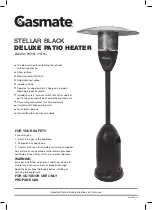
12
wet pavement as measured under controlled conditions on
specified government test surfaces of asphalt and concrete.
A tire marked C may have poor traction performance.
Warning: The traction grade assigned to this tire is based on
straight-ahead braking traction tests, and does not include
acceleration, cornering, hydroplaning, or peak traction
characteristics.
TEMPERATURE
The temperature grades are A (the highest), B, and C,
representing the tire’s resistance to the generation of heat
and its ability to dissipate heat when tested under controlled
conditions on a specified indoor laboratory test wheel.
Sustained high temperature can cause the material of the tire
to degenerate and reduce tire life, and excessive temperature
can lead to sudden tire failure.The grade C corresponds to
a level of performance which all passenger car tires must
meet under the Federal Motor Safety Standard No. 109.
Grades B and A represent higher levels of performance on
the laboratory test wheel than the minimum required by law.
Warning: The temperature grade for this tire is established for
a tire that is properly inflated and not overloaded. Excessive
speed, underinflation, or excessive loading, either separately
or in combination, can cause heat buildup and possible tire
failure.
Additional Information on Light Truck Tires
Tires for light trucks have other markings besides those found
on the sidewalls of passenger tires. See Figure 2 and the
information following.
2
A-
The “LT” indicates the tire is for light trucks. An “ST” is an
indication the tire is for trailer use only.
B-
Load Range. This information identifies the tire’s load-
carrying capabilities and its inflation limits.
C-
Maximum Load Dual. This information indicates the
maximum load and tire pressure when the tire is used as a
dual, that is, when four tires are put on each rear axle (a total
of six or more tires on the vehicle).*
D-
The "M+S" or "M/S" indicates that the tire has some mud
and snow capability. Most radial tires have these markings;
hence, they have some mud and snow capability.
E-
This information indicates the maximum load and tire
pressure when the tire is used as a single.*
*Maximum load is presented in kilograms and pounds (kg/
lbs). Maximum tire pressure is presented in kilopascals and
pounds per square inch (kPa/psi) for when the tire is cold.
Tire Safety Tips
Preventing Tire Damage
• Slow down if you have to go over a pothole or other
object in the road.
• Do not run over curbs of foreign objects in the roadway,
and try not to strike the curb when parking.
Tire Safety Checklist
• Check tire pressure regularly (at least once a month),
including the spare.
• Inspect tires for cracks, foreign objects, uneven wear
patterns on the tread, or other signs of wear or trauma.
• Remove bits of glass and foreign objects wedged in the
tread.
• Make sure your tire valves have valve caps.
• Check tire pressure before going on a long trip.
• Do not overload your vehicle. Check the tire information
placard or owner’s manual for the maximum
recommended load for the vehicle.
Features and Controls
Compare Figures 3 through 7 with the tables following.
Unit (from left front)
3
Ref
Description
A
Upper Storage Compartment Door
B
Lower Storage Compartment Door
C
Lunette Ring
D
Bulldog Hitch
E
Safety Chains (2)
Not for
Reproduction













































